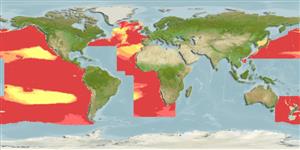>
Lophiiformes (Anglerfishes) >
Oneirodidae (Dreamers)
Etymology: Microlophichthys: Greek, 'mikros' = small + Greek, 'lophos' = crest or tuft + Greek, 'ichtys' = fish (put together, alludes to this "fish with a tiny lure") (Ref. 86949).
More on author: Regan.
Environment: milieu / climate zone / depth range / distribution range
Οικολογία
Θαλασσινό(ά) βαθυπελαγικό(ς); εύρος βάθους 800 - 2200 m (Ref. 86949). Deep-water
Tropical and subtropical parts of all oceans.
Μέγεθος / Βάρος / Age
Maturity: Lm ? range ? - ? cm
Max length : 11.8 cm TL (female)
Short description
Κλείδες προσδιορισμού | Μορφολογία | Μορφομετρία
Μαλακές ραχιαίες ακτίνες (συνολικά) : 5 - 7; Μαλακές εδρικές ακτίνες: 4 - 6. Metamorphosed females distinguished by the following characteristics: wide ethmoid cartilage and vomer, wider than distance between anterolateral tips of lateral ethmoids and frontals; presence of vomerine teeth; large and nearly circular nasal foramina; frontals short, lying posterior to the ethmoid region, dorsal margin convex; ventromedial extensions of frontals approach each other on midline, making contact with parasphenoid; frontals separated from prootics; presence of pterosphenoid; anterior end of illicial trough wider and shallower than posterior end; well developed sphenotic spines; symphysial cartilage of upper jaw longer than wide; lower jaw with well developed symphisial spine; hyomandibula with double head; well developed quadrate spine, longer than articular spine; deeply notched posterior margin of opercle; short and broad subopercle, dorsal end rounded or tapering to a blunt point, ventral end nearly circular; first pharyngobranchial reduced to a tiny remnant; absence of second hypobranchial; caudal fin rays without internal pigmentation; extremely short illicium, approximately equal to length of escal bulb; pterygiophore of illicium cylindrical throughout, emerging on snout from between frontal bones, anterior end barely exposed, posterior end concealed beneath the skin; first ray of dorsal fin well developed; dorsal fin rays 5-7; anal fin rays 4-6; short and broad pectoral fin lobe, shorter than longest rays of pectoral fin; pectoral fin rays 18-20; coracoid lacking posteroventral process; simple pelvic bones, with or without distal expansion; skin smooth and naked, without dermal spinules; darkly pigmented skin of caudal peduncle extends well past base of caudal fin (Ref. 86949).
Also mesopelagic (Ref. 10524).
Life cycle and mating behavior
Maturities | Αναπαραγωγή | Spawnings | Egg(s) | Fecundities | Προνύμφες
Bertelsen, E., 1990. Oneirodidae. p. 498-507. In J.C. Quero, J.C. Hureau, C. Karrer, A. Post, and L. Saldanha (eds.) Check-list of the fishes of the eastern tropical Atlantic (CLOFETA). JNICT, Lisbon; SEI, Paris; and UNESCO, Paris. Vol. 1. (Ref. 10524)
IUCN Red List Status (Ref. 130435)
Threat to humans
Harmless
Human uses
Εργαλεία
Special reports
Download XML
Διαδικτυακές πηγές
Estimates based on models
Preferred temperature (Ref.
123201): 2.4 - 5, mean 3.8 °C (based on 313 cells).
Phylogenetic diversity index (Ref.
82804): PD
50 = 0.7500 [Uniqueness, from 0.5 = low to 2.0 = high].
Bayesian length-weight: a=0.01000 (0.00244 - 0.04107), b=3.04 (2.81 - 3.27), in cm total length, based on all LWR estimates for this body shape (Ref.
93245).
Τροφικό Επίπεδο (Ref.
69278): 3.7 ±0.5 se; based on size and trophs of closest relatives
Ελαστικότητα (Ref.
120179): Μεσαίο(α), ελάχιστος χρόνος για διπλασιασμό πληθυσμού 1,4 - 4,4 έτη (Fecundity assumed < 1000).
Fishing Vulnerability (Ref.
59153): Low vulnerability (10 of 100).
